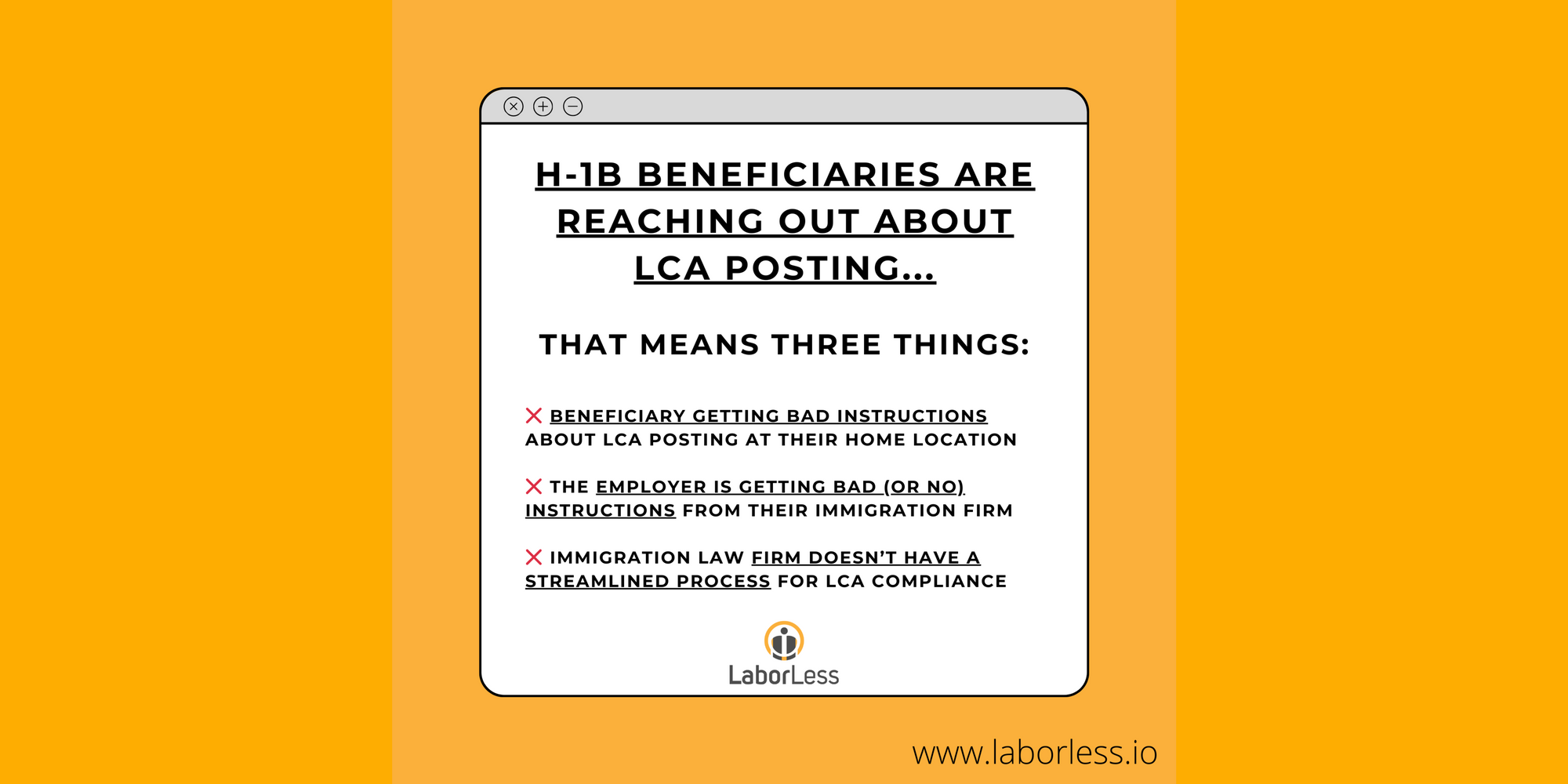Every year around H-1B cap season, we got lots of inbound interest from immigration law firms and in-house teams about Labor Condition Application (LCA) compliance and Public Access File (PAF) automation. But this year, a different request keeps appearing in the inbox:
“My company says I have to post my Labor Condition Application notice. Can LaborLess help?”
No, this isn't coming from an HR team or in-house immigration professional.
Instead it's from an individual H-1B beneficiary whose company is filing an H-1B petition on their behalf.
If an H-1B beneficiary is actively looking for a tool to satisfy LCA posting rules, the compliance chain is already fraying. A foreign national should never be asked to handle an employer obligation—and the mere fact they are reveals three deeper problems:
- The worker has received little or no instruction and is trying to fill the gap alone.
- The company’s HR team lacks a clear playbook from their immigration counsel and therefore offloads responsibility.
- The law firm itself does not have a scalable, client-friendly process for LCA and PAF compliance.
So, this blog dives into what the regulations actually require—including for home-office worksites—followed by an explanation of why “DIY” posting exposes companies to risk and a look at how electronic LCA posting with automated PAF management can remove beneficiaries from the process altogether.
What the LCA Compliance Regulations Require
Employer Responsibility
Under 20 C.F.R. § 655.734, the employer must notify U.S. workers of every LCA on or within 30 days before filing Form ETA-9035. That notice must remain available for ten consecutive calendar days when posted on a physical or electronic bulletin board. Employers may satisfy the rule in one of two ways:
- by posting hard-copy notices in at least two conspicuous locations at the place of employment, or
- by providing electronic notice through any channel the company ordinarily uses—e-mail, intranet, or an online portal.
In addition, each H-1B employee must receive a copy of the certified LCA no later than the first day of work. Nowhere do the regulations permit the duty to be shifted to the beneficiary.
Remote and Home-Office Worksites
Distributed work has blurred what counts as a “place of employment.” DOL guidance issued in August 2023 confirms that moving an H-1B professional to another spot within the same metropolitan statistical area does not require a new LCA—but the notice obligation follows the worker. Practically speaking, a home office is a worksite. A compliant notice for remote staff therefore, assuming physical postings in their apartment is off the table, takes one of two forms:
A direct e-mail sent to all employees in the same occupational classification (which eliminates the ten-day posting window), or
An electronic bulletin board accessible to every affected worker for ten days.
Printing an LCA and taping it to a refrigerator door may feel symbolic, yet it is not really necessary and—when undocumented—ineffective.
Why Beneficiary-Led LCA Posting Can Create Risk
Statutory Duty Shifts to the Wrong Person
The Department of Labor places the LCA notice obligation squarely on the employer. When the task is off-loaded to a foreign national who is unfamiliar with 20 C.F.R. § 655.734, management may lose control of a requirement that carries civil money penalties and, in repeat cases, potential debarment from the H-1B program. What should be a straightforward, employer-driven step can turn into a compliance gamble.
Proof for the Public Access File Becomes Unreliable
A defensible PAF needs timestamped evidence of notice and must be retained for one year past date of LCA expiry or the last date of the beneficiary's employment, whichever is first. When an employee snaps a photo on a personal phone—or forgets altogether—that proof may never reach HR or outside counsel. Missing or unverifiable documentation undermines the file’s integrity, leaving the company vulnerable in a Wage-and-Hour audit.
Employee Experience Suffers on Day One
An H-1B professional should spend their first days focused on onboarding and productivity, not worrying about violating immigration status. Asking the beneficiary to manage postings introduces anxiety and distraction, eroding confidence in both the employer and its legal team. It's even worse if they haven't even started yet and are merely a candidate waiting to be selected in the H-1B lottery.
Audit Outcomes Grow More Hazardous
During a DOL investigation, clear, centralized records speak for themselves. If evidence is scattered across inboxes or stored on personal devices, investigators may interpret the gaps as willful non-compliance, leading to back-pay orders, fines or H-1B debarment. A process designed for convenience in the short term becomes a costly liability in the long run.
Civil-money penalties can exceed $2,000 per violation, and repeat offenses risk debarment from the H-1B program.
How Traditional LCA Compliance Workflows Break Down
A major root cause of most LCA mishaps is lack of process. An immigration lawyer e-mails a PDF of the LCA posting notice to a client’s HR manager, who forwards it to a division lead, who then tells the beneficiary to print the notice at home and “send a photo in ten days.” The reminder gets buried, and the proof never reaches the PAF. Multiply that scenario across dozens, hundreds or more petitions, remote locations, and client sites, and gaps become inevitable. Even the most meticulous spreadsheets struggle to keep pace with modern distributed teams and compressed cap-season timelines.
Electronic LCA Posting and Automated PAF Management
A technology-first approach solves the problem at its source. LaborLess provides a single workflow that keeps beneficiaries out of compliance tasks altogether.
With LaborLess, the user (whether in-house immigration team or outside immigration lawyer) poss an LCA notice on the platform for the required ten days, the posting period is automatically logged, and the evidence drops into the PAF without manual intervention.
All documents remain accessible for the full retention period and can be accessed and downloaded instantly in the event of an audit or investigation.
And, because LaborLess can now connect via API to immigration case-management systems, the need to re-enter LCA data has decreased dramatically as well. Firms save hours per petition while employers gain an efficient, uniform process.
FY 2026 H-1B Cap-Season Deadline Is Closer Than You Think
For most employers, the FY-2026 H-1B cap season ends on 30 June 2025, when last-minute LCAs must be certified, petitions finalized and submitted, and PAFs assembled. Organizations that still rely on manual posting, and place the responsibility on the H-1B beneficiary for remote / hybrid roles are adding risk to their immigration process for now reason.
Automate LCA Compliance with LaborLess
Asking a foreign national to pin an LCA notice to a kitchen wall may seem convenient, but, in our view, contradicts the spirit of Department of Labor regulations. Modern technology allows employers and their immigration law firms to handle the LCA compliance responsibility themselves—protecting workers, satisfying auditors, and preserving valuable legal bandwidth.
Ready to modernize your LCA process? Check out our demo HERE. LaborLess can onboard a law firm or in-house mobility team in as little as 24–48 hours, delivering electronic posting, automated PAF management, reporting and more well before the H-1B filing deadline.
Contact us today!

